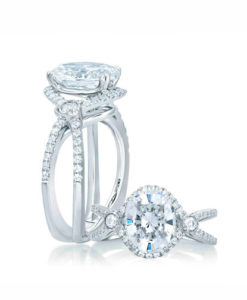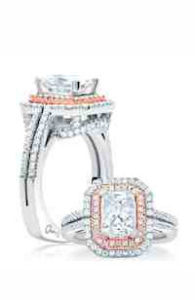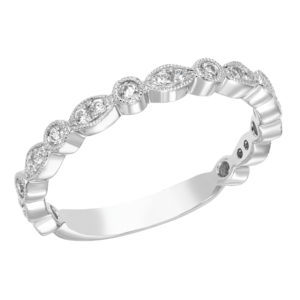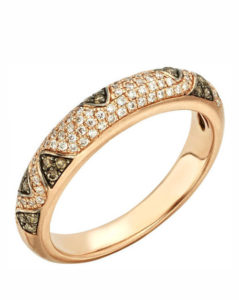Platinum Rewards
Consumer research reveals that desire for platinum is high. Young consumers looking for tailored, elegant looks are gravitating to platinum. They like the platinum story: The naturally white qualities of platinum, as well as its strength and durability make it a great choice and value for consumers. Platinum also adds value to retailers’ bottom line and is a mark of distinction in a crowded field.
 Nearly 80% of consumers want platinum for their wedding rings, either their first choice or a serious consideration. But research shows that only 15% of consumers actually buy platinum, says Kevin Reilly, PGI-USA vice president. He says a big part of the problem is the sales staff does not understand the benefits of platinum to bring it up, instead steering consumers to white gold.
Nearly 80% of consumers want platinum for their wedding rings, either their first choice or a serious consideration. But research shows that only 15% of consumers actually buy platinum, says Kevin Reilly, PGI-USA vice president. He says a big part of the problem is the sales staff does not understand the benefits of platinum to bring it up, instead steering consumers to white gold.
“Platinum is the finest precious metal in the world, particularly for wedding jewelry,” tells Reilly, who notes it’s 30% more rare than gold. “Nothing holds a diamond as securely as platinum, and its natural white color will never fade or tarnish, whereas white gold, an alloy using yellow gold, is usually re-plated to maintain its look. Platinum also is incredibly dense, so it feels heavier than other metals (40% heavier than comparable gold ring). Moreover, platinum is 95% pure, whereas 18K gold is 75%, 14K 50%; and it’s naturally hypoallergenic.”
For the better part of two years, platinum has been trading below gold—$200 less an ounce—so prices are very favorable. “The difference in purity and density make platinum slightly more expensive,” explains Reilly.
Pushing Platinum Heads
To re-energize the category, PGI is working with manufacturers and jewelers to push platinum heads, to give consumers the opportunity to protect their important gemstone with the very best metal for the job, even if they opt for a gold shank.
“We hope it will lead consumers to buy an entirely platinum ring, but in starting the conversation this way we’re  educating them about platinum’s key role in securing the stone, the most expensive component of the ring,” tells Reilly. “If we concentrate on converting all heads to platinum, we could significantly change the conversation with consumers and increase profits for retailers.”
educating them about platinum’s key role in securing the stone, the most expensive component of the ring,” tells Reilly. “If we concentrate on converting all heads to platinum, we could significantly change the conversation with consumers and increase profits for retailers.”
Research shows that once consumers know the importance of the setting for the security of the stone, 94% are willing to set their diamond in platinum. Moreover, they’d pay nearly $500 more on average to do so. “There’s a huge opportunity for retailers to bump up profitability and present a point of differentiation.”
Angelique Crown, director of sales west region A.Jaffe, praises PGI’s program, for which the New York City manufacturer participates. “We’re launching new collections with platinum heads and 18K gold shanks. The difference in price between 18K gold and platinum makes platinum an everyday elegance.”
A.Jaffe has always offered platinum in its bridal category, says Crown, noting the brand has incorporated price adjustments that reflect a 30% decrease, promoting its attainability. “We’re offering unique opportunities to our retailers and their customers to indulge in platinum.”
PGI is working with editors, developing print and digital advertising, and conducting a retailer survey. Reilly advocates jewelers take advantage of the free sales training online at platinumlearning.com—six animated shorts designed to excite sales about platinum, and 30 platinum bench jeweler benchmark modules.
 Pulse on Platinum
Pulse on Platinum
Stackable rings remain bestsellers, in platinum bridal and fashion, says Jill Moynihan, PGI USA manager of marketing and communications. “We’re seeing thinner, fashion bands used as wedding and right hand rings. Brides are attracted to the stacking style because they can add rings to personalize the look.” She cites Phyllis Bergman of Mercury Ring, a division of Interjewel Group, New York as offering great assortment in this category.
Bergman hails diamond bands as the big story in the category, citing an enormous opportunity for the jewelry industry because they appeal to multiple generations and for many occasions. Petite bands that can be worn with engagement rings, separate, or stacked are popular, especially bands that mix diamond shapes like oval, marquise, pear, and tapered baguette.
Another trend in platinum bridal, says Moynihan, is a greater use of color stones. “Brides are looking to color as a way to personalize their rings. Gemstones are used to symbolize the bride’s birthstone or month the couple got  engaged.”
engaged.”
Reilly sees a big opportunity in platinum for those who carry it, from bridal to fashion, including stud earrings, chain, pendants, and bracelets. In fact, PGI is launching a revamped website, featuring a new Design Gallery of manufacturers, designers and jewelers working in platinum.










